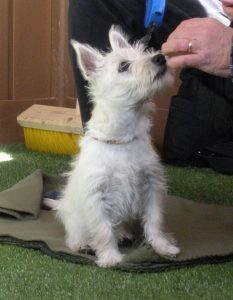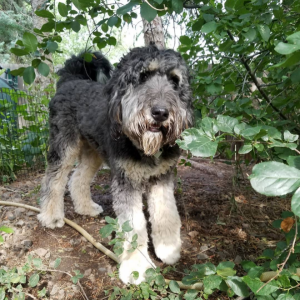
Among all the positive methods used to train animals, the method I use is clicker training, and it is particularly effective. Your clicker trained dog will learn to offer behaviors to you on purpose, rather than simply following his nose and repeating a habitual trick. The difference between an animal that behaves with intention, rather than simply by habit, is vast.
Clicker trained animals try to learn new behaviors!
They remember behaviors even years later because they were aware of them as they learned them, rather than just following a lure and acquiring them without awareness. Because of their own involvement in their learning, they develop self-confidence — they realize they have control over their behavior and their ability to earn rewards. Clicker training produces dogs who love to learn!

Will I Always Need To Use A Clicker?
No. Once a behavior is learned and on cue, there’s usually no need to click, as the animal understands the behavior. Clicker trainers can maintain the behavior by replacing special good treats with occasional and less intensive rewards including a pat or praise. Learned cues and behaviors are also maintained by real-life rewards: for example sitting quietly at the door is rewarded by opening the door so that the dog can have a walk. Clicker trainers then save clicks and treats for the next new thing they want to train.

Can Clicker Training Help Get Rid of Behaviors I Don’t Want?
Clicker trainers allow unwanted behaviors to disappear through lack of reinforcement. If a behavior is not rewarding to the animal, eventually it will disappear. If an unwanted behavior persists, clicker trainers study the behavior to understand why it is reinforcing to the animal. Sometimes the behavior reinforces itself: a barking dog is less bored than a quiet dog. The barking is its own reward. The clicker trainer provides this dog with an alternate wanted behavior to replace the unwanted behavior. The bored dog may simply need more activity, or perhaps quiet resting for longer and longer periods can become a rewarded behavior. Then the clicker trainer would teach the dog a cue for “silence.”
Why Use The Clicker? Why Not Just A Word?
A click is more powerful for training than a spoken word because it is not a sound heard by the animal in other circumstances. It means one thing only: a reward is coming because of what you did when you heard the click. It can be produced instantly and at the exact moment a behavior occurs. Even a very quick and subtle behavior, the twitch of an ear for example, can be clicked.
Unlike our voices, which can say the same word in different ways, and so express different emotions or meanings each time, the click sounds the same every time it is heard; its meaning never varies. Humans are highly verbal creatures, but our pets are not. It can be difficult for them to pick out a single word from the stream of meaningless words they hear us speak every day. The click’s meaning, however, is always clear. It is always directed at the animal, and it is always good news.
The clarity with which a click enables trainers to communicate with their animals has a profound effect on their relationships. Their level of interaction increases, and trainer and animal become more interesting and fun for each other.